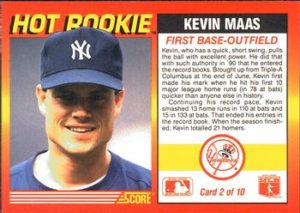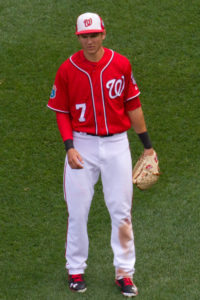
Everybody’s buddy and fine fantasy baseball analyst, Howard Bender, had a piece in the NY Post this week warning about overestimating Turner this year, the way Carlos Correa was overestimated last year.
That’s good advice in general, and probably as it applies to Turner, but it raises the question of how do you draw the line on a young player with a spectacularly good partial season under his belt.
I looked at hitters who had an OPS+ of 130 or better in the year they lost their rookie status since 1980 (the Roto Era), who had 249 plate appearances or more. Sixty one hitters qualified.
Five of those seasons came in 2016. That would be Corey Seager, Aledmys Diaz, Trea Turner, and the Ryans Shrimpf and Healy. One player, Kyle Schwarber, had a qualifying first season and didn’t play the next. That leaves us with 55 hitters in the pool.
What can we learn from them?
If we sort them from top to bottom based on first year OPS+:
 The top 11 had an an OPS+ of 157 in year 1 and an OPS+ of 137 in year 2. Two of this group improved in year two, a man named Trout and another named Greenwell. Three had less than a 130 OPS in year 2: Luke Scott, posterboy Kevin Maas, and Miguel Sano. This group averaged 499 plate appearances.
The top 11 had an an OPS+ of 157 in year 1 and an OPS+ of 137 in year 2. Two of this group improved in year two, a man named Trout and another named Greenwell. Three had less than a 130 OPS in year 2: Luke Scott, posterboy Kevin Maas, and Miguel Sano. This group averaged 499 plate appearances.
The next 11 averaged 143 in year 1, and 109 in year 2. One of this cohort, Randy Milligan, improved. Seven had less than a 130 OPS+. Five has less than a 100 OPS+. This group averaged 442 plate appearances.
The middle 11 averaged 137 in year 1, and 116 in year 2. Kris Bryant was the only one to improve. Two were better than 130 in year 2. Only two had less than a 100 OPS+, both at 99, which is why the year 2 average went up for this group. This group averaged 349 plate appearances.
The fourth 11 average 133 in year 1, and 120 in year 2. Ryan Howard and Jason Bay improved. They were also the only two to have an OPS+ the next year better than 130. None of this group has an OPS+ of less than 100. This group averaged 416 plate appearances.
The last quintile averaged 131 in year 1, and 113 in year 2. Josh Hamilton, John Kruk, Lonnie Smith, and Ryan Klesko all improved and had an OPS+ of better than 130. Four hitters had an OPS+ of less than 100. This group averaged 343 plate appearances.
Another way to split these guys into groups would be by plate appearances.
The top quintile averaged 639 plate appearances, with a 151 OPS+ in year 1, and a 137 OPS+ in year 2.
The next group averaged 463 plate appearances, with a 141 OPS+ in year 1, and a 136 in year 2.
The middle quintile averaged 388 PA, with a 138 in year 1, an 85 in year 2.
The fourth group averaged 337 PA, with a 135 in year 1, a 122 in year 2.
The last group averaged just 273 PA, with a 139 in year 1, a 116 in year 2.
All in all, 20 of the 55 players did better than 130 in OPS+ in year 2, 25 did better than 120 OPS+, 33 did better than 110, and 48 did better than 100. That leaves seven true busts, and 30 total who could be considered disappointing.
Eleven of the 20 players who topped 130 in OPS+ had more than 450 plate appearances. Only four of the next 20 players had 450 PA or more.
A final set of ranks, based on percentage of change from year 1 to year 2.
The top quintile averaged 428 plate appearances, posting a 138 OPS+ in year 1, and a 154 in year 2.
The next averaged 508 PA, with 142 in year 1, 131 in year 2.
The middle quintile averaged 415 PA, with a 141 OPS+ in year 1, a 116 in year 2.
The fourth quintile averaged 352 PA, with a 137 OPS+ in year 1, and a 103 in year 2.
The bottom quintile averaged 388 PA, with a 153 OPS+ in year 1, and an 85 in year 2.
Comparing the top half sorted by percentage of change from year 1 to year 2, the top half had 487 plate appearances while the bottom half had 384. The average age of the top half was 23.4 years old, while the bottom half was 24.5. Perhaps not surprisingly, the bottom half hit more homers and stole more bases per plate appearance.
Plate appearances and high OPS+ are the best indicators of a repeat season of top performances for these players, but players of all types do repeat and get better.
So, what happens if we look at only those players with fewer than 450 PA in year 1? There are 37 of them.
Sort them into thirds, and we see that the top two thirds are younger than the bottom third. Older is definitely worse when you’re looking at partial seasons with a high OPS+ in your rookie year. Or maybe it is better put, younger is definitely better.
So, what do we make of this year’s crop?
Corey Seager and Aledmys Diaz should be the most trusted, because they had the most at bats, but neither had a particularly high OPS+ last year, which is a bit of a warning sign. And Diaz is somewhat older, a reason to distrust.
 Trea Turner had the best OPS+ last year, but only 324 plate appearances. Still he’s young, which is a positive sign.
Trea Turner had the best OPS+ last year, but only 324 plate appearances. Still he’s young, which is a positive sign.
Ryan Shrimpf just snuck onto the list at 130 OPS+. He’s 28 years old, very old, and only had six more PA than Turner. He’s neg all the way.
Finally, Ryon Healy is slightly old, with a 135 OPS+, and only 283 PA. Not as negative as Shrimpf, but not as positive as the other guys.
Bonus No. 1: Kyle Schwarber missed last year, but will be back this year after a powerful world series. He’s still young, but is coming off a 130 OPS+ in 2015. He’s a mixed bag until you see him swing.
Bonus No. 2: Gary Sanchez didn’t make the 250 PA cutoff, but in 229 PA last year he put up a monster 168 OPS+. Only Mike Trout and Jose Abreu did better in our 250+ PA cohort. On the other hand, if you look at the cohort of those who didn’t qualify, the only hitters who did better in year 1 were Frank Thomas and Phil Plantier. Both were 22 their rookie year. Thomas followed up his 177 OPS+ rookie year with a league leading 180 the next year, and then 177, 174, 212, 179, 178, 181 in the next six years. Plantier followed his 178 with a 90 and never topped the 122 he had in year 3.
Finally, what to do with all this? Although there is data here, this sort of study is really anecdotal. The sample is small, the results so various as to mock any absolute conclusions. But maybe you read the above and feel differently.
What I think it tells us is that there are players who post a super first season and then repeat. You can’t rule that out for these guys this season.
But as you would expect, extreme performance usually regresses to the mean, so you should not count on a repeat. And you should fear charging ahead taking anyone with such a small performance sample, because the possibility of sophomore slump is always there (except for Corey Seager, right?).
Which is pretty dull and which brings us to Howard’s comment about Trea Turner. He says, “Of course Turner is a great talent, but just doubling his total because he will get twice the at-bats this year is not the proper way to project.”
The trouble with Turner is that even if you regress back his stats you end up with ridiculous numbers. My projection, which doesn’t come close to doubling last year’s numbers is 18 homers, with 49 steals, a modest 93 runs and 68 RBI, with a .307 batting average. In 5×5, that’s worth $37. First-round value.
ZIPS chops more aggressively. It gives Turner 260 more plate appearances than last year and one more homer, three more steals, a .282 batting average and modest 77/66 runs and RBI split. But even that modest projection is worth $29, which is a Top 15 hitter.
Is my projection the median projection? Is ZIPS’? That’s the trouble with Turner. Right now I have him with an NL-only bid price of $27. That’s not going to get him, and paying more isn’t necessarily going to hurt the team that buys him.
So, what you do is you keep bidding. Certainly to $27, maybe to $30. This is a place to read the room. Once you’re at $30 you don’t really want him, but the risk of bidding up the guy who does really want him isn’t huge. I mean, you might end up with Trea Turner!
At that price, that could be trouble, but might not.
Here’s a link to the data, both that which I used and that which I didn’t.
